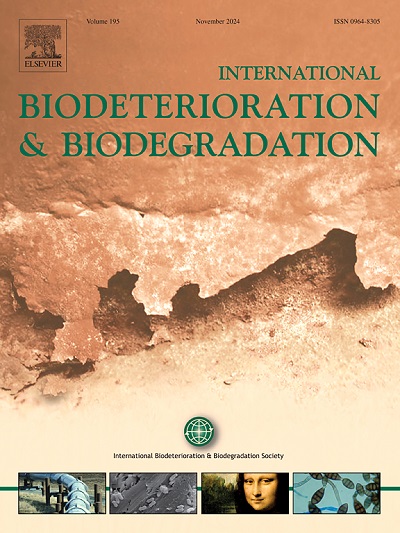Functional characterization of an efficient chloroxylenol-degrading bacterial consortium
IF 4.1
2区 环境科学与生态学
Q2 BIOTECHNOLOGY & APPLIED MICROBIOLOGY
International Biodeterioration & Biodegradation
Pub Date : 2025-02-01
DOI:10.1016/j.ibiod.2025.105999
引用次数: 0
Abstract
Chloroxylenol (synonym, para-chloro-meta-xylenol [PCMX]), a halogenated phenolic disinfectant, is widely used for disinfection or in personal care products. Due to the global COVID-19 pandemic, the widespread use of PCMX has undoubtedly led to its prevalence in various environments, resulting in a high detection frequency. However, there have been few reports on the aerobic microbial community and pure culture degradation of PCMX. In this study, a PC2 consortium with an efficient PCMX decomposition was successfully obtained. Rhodococcus was significantly enriched in consortium PC2 after the acclimation. Subsequently, a PCMX-degrading pure culture strain, Rhodococcus sp. JH-7, was isolated, and the degradation characteristics were investigated. Meanwhile, a key metabolic intermediate (4-chloro-3,5-dimethylcatechol) was identified by LC-TOF-MS and a new biodegradation pathway of PCMX was proposed. Additionally, Rhodococcus sp. JH-7 could protect Escherichia coli, Pichia pastoris, Chlorella ellipsoidea and Chlamydomonas reinhardtii from the toxicity of PCMX, indicating that the biodegradation of PCMX was a detoxification process. This study reveals a catabolic pathway of PCMX and provides new insights for the bioremediation of PCMX-contaminated environments.
一种高效氯氧二酚降解菌群的功能表征
氯二甲酚(又称对氯-间二甲酚[PCMX])是一种卤代酚类消毒剂,广泛用于消毒或个人护理产品中。由于全球COVID-19大流行,PCMX的广泛使用无疑导致其在各种环境中流行,导致其检测频率很高。然而,关于PCMX的好氧微生物群落和纯培养降解的报道很少。在这项研究中,成功地获得了一个高效分解PCMX的PC2联合体。驯化后,红球菌在联合体PC2中显著富集。随后,分离出一株降解pcmx的纯培养菌株Rhodococcus sp. JH-7,并对其降解特性进行了研究。同时,通过LC-TOF-MS鉴定了PCMX的关键代谢中间体(4-氯-3,5-二甲基儿茶酚),并提出了一种新的生物降解途径。此外,红球菌sp. JH-7对大肠杆菌、毕赤酵母、椭球小球藻和莱茵衣单胞菌具有保护作用,表明PCMX的生物降解是一个解毒过程。本研究揭示了PCMX的分解代谢途径,为PCMX污染环境的生物修复提供了新的思路。
本文章由计算机程序翻译,如有差异,请以英文原文为准。
求助全文
约1分钟内获得全文
求助全文
来源期刊
CiteScore
9.60
自引率
10.40%
发文量
107
审稿时长
21 days
期刊介绍:
International Biodeterioration and Biodegradation publishes original research papers and reviews on the biological causes of deterioration or degradation.

 求助内容:
求助内容: 应助结果提醒方式:
应助结果提醒方式:


